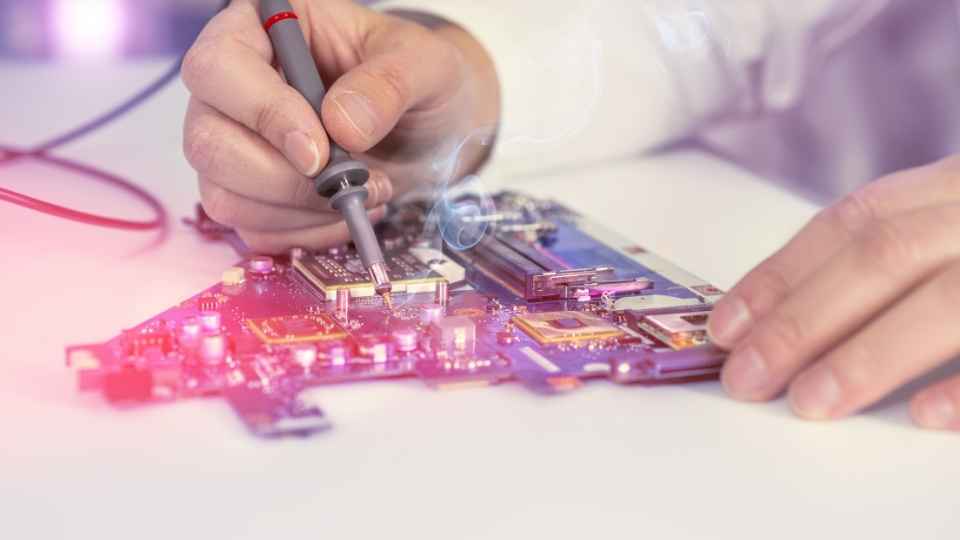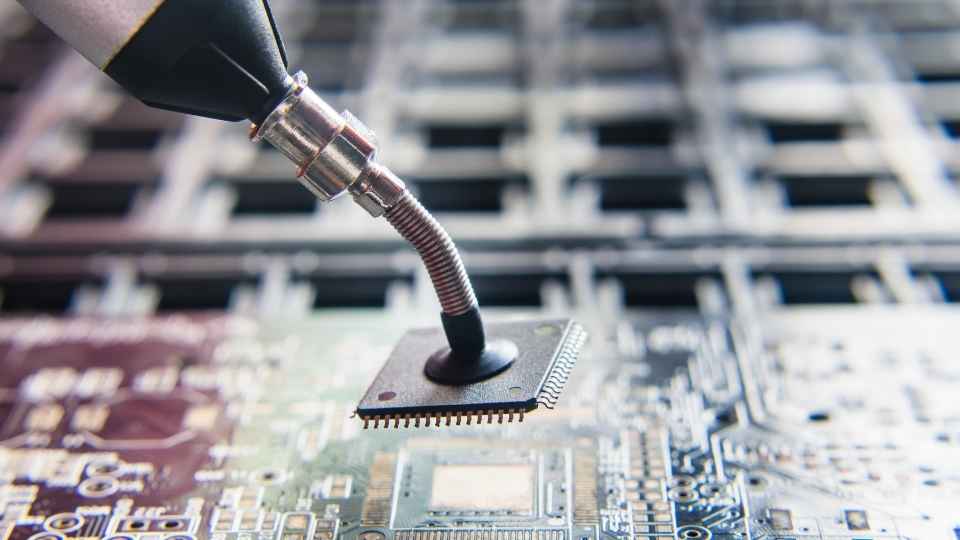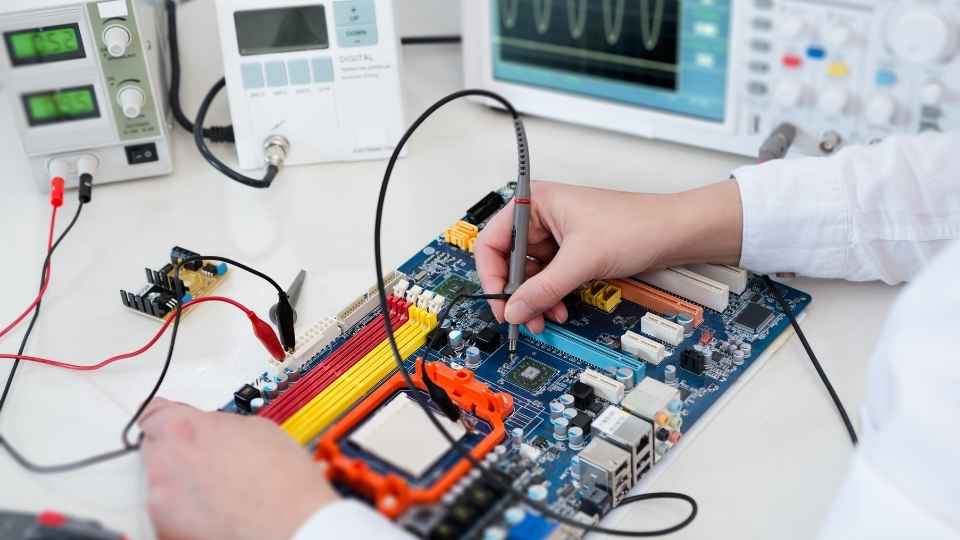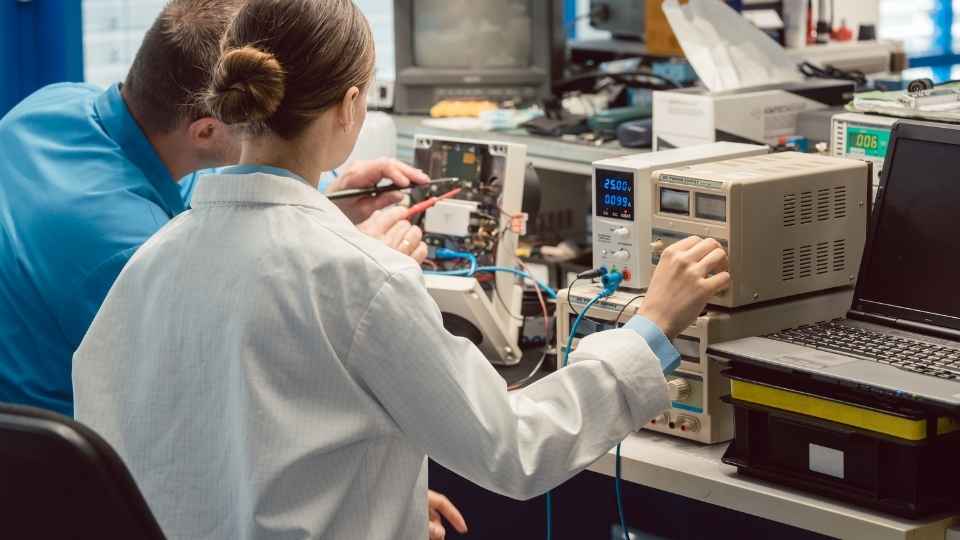
In the vast realm of technology, one innovation has truly revolutionized the world of Integrated Circuit (IC) Design: CMOS Technology.
Like a phoenix rising from the ashes, CMOS has emerged as a game-changer, completely transforming the landscape of ICs.
With its technical prowess and precision, this cutting-edge technology has paved the way for unparalleled advancements in power consumption, miniaturization, and performance enhancement.
Join us on this captivating journey as we delve into the realm of CMOS Technology and unravel its impact on IC design.
Key Takeaways
- Continuous scaling down of transistor dimensions and increased transistor density have allowed for more functionality in smaller devices.
- CMOS technology offers advantages such as power efficiency, miniaturization, and integration of complex circuits, overall performance enhancement, and extended battery life.
- The power efficiency of CMOS technology leads to extended battery life, reduced heat dissipation, cost savings, and environmental friendliness.
- The miniaturization and integration benefits of CMOS technology result in smaller, more compact ICs, increased functionality and performance, improved power efficiency, longer battery life, and enhanced user experience and convenience.
The Evolution of CMOS Technology in IC Design
The evolution of CMOS technology in IC design has significantly impacted the efficiency, performance, and miniaturization of integrated circuits.
CMOS (Complementary Metal-Oxide-Semiconductor) is a type of semiconductor technology that utilizes both P-type and N-type transistors to achieve low power consumption and high noise immunity.
Over the years, CMOS technology has undergone several advancements that have revolutionized IC design.

One key development is the continuous scaling down of transistor dimensions, leading to increased transistor density on a chip. This allows for more functionality to be packed into smaller devices, enabling the creation of powerful yet compact electronic systems.
Additionally, improvements in manufacturing processes have resulted in higher yield rates and reduced production costs.
These advancements in CMOS technology have paved the way for innovative applications across various industries, from consumer electronics to healthcare and automotive sectors.
Understanding the basics of CMOS technology will provide further insight into its impact on IC design.
Understanding the Basics of CMOS Technology
Understanding the basics of CMOS technology provides insight into its transformative impact on integrated circuit design. Here are four key aspects to consider:
Low Power Consumption: CMOS (Complementary Metal-Oxide-Semiconductor) technology is known for its low power consumption, making it ideal for portable devices and battery-operated applications.
High Integration Density: CMOS allows for high levels of integration, enabling more components to be packed onto a single chip. This has led to the development of smaller and more powerful electronic devices.

Noise Immunity: CMOS circuits have excellent noise immunity, meaning they can operate reliably even in noisy environments without significant signal degradation.
Digital and Analog Capabilities: CMOS technology is versatile and can handle both digital and analog signals effectively, making it suitable for a wide range of applications in various industries.
Advantages of CMOS Technology in Integrated Circuit Design
CMOS technology offers several advantages in integrated circuit design.
Firstly, it provides power efficiency by allowing for low power consumption and reducing heat dissipation.
Secondly, CMOS enables the miniaturization and integration of complex circuits, leading to smaller devices with higher functionality.
Lastly, CMOS technology enhances overall performance and speed, making it a preferred choice for various applications in the field of integrated circuit design.
Power Efficiency of CMOS
One notable aspect of CMOS technology is its exceptional power efficiency, which has greatly impacted integrated circuit design. This power efficiency has led to several significant benefits for IC designers and users alike:

Extended battery life: The low power consumption of CMOS circuits allows devices such as smartphones, tablets, and wearables to operate for longer periods without requiring frequent recharging.
Reduced heat dissipation: With lower power requirements, CMOS circuits generate less heat during operation, leading to improved reliability and longevity of electronic devices.
Cost savings: By reducing the power consumption of integrated circuits, CMOS technology helps minimize energy costs for both manufacturers and end-users.
Environmental friendliness: Lower power consumption translates into reduced carbon emissions and a smaller ecological footprint, making CMOS-based devices more environmentally sustainable.
The exceptional power efficiency offered by CMOS technology has paved the way for further advancements in miniaturization and integration benefits in integrated circuit design.
Miniaturization and Integration Benefits
The miniaturization and integration benefits brought about by the power efficiency of CMOS technology have had a significant impact on the development and advancement of electronic devices. CMOS (Complementary Metal-Oxide-Semiconductor) technology has enabled the creation of smaller, more compact integrated circuits (ICs), leading to increased functionality and performance in various electronic applications.
By reducing the size of transistors and other components, CMOS technology has allowed for the integration of complex circuitry onto a single chip. This integration has resulted in smaller form factors, improved portability, and enhanced functionality in devices such as smartphones, tablets, laptops, and wearable gadgets.

Furthermore, the miniaturization made possible by CMOS technology has led to increased power efficiency. Smaller components require less power to operate, resulting in longer battery life for portable devices. This freedom from frequent charging or dependence on external power sources enhances user experience and convenience.
Overall, the miniaturization and integration benefits brought about by CMOS technology have revolutionized IC design by enabling smaller form factors with enhanced functionality while improving power efficiency. This advancement has provided users with greater freedom in using their electronic devices.
Improved performance and speed are key factors in the advancement of electronic devices, allowing for faster processing and more efficient operation. The continuous development of CMOS (Complementary Metal-Oxide-Semiconductor) technology has played a pivotal role in achieving these goals. Here are four ways CMOS technology has revolutionized integrated circuit (IC) design:
Reduced power consumption: CMOS circuits consume less power compared to other technologies, making them ideal for portable devices that require longer battery life.
Increased integration density: CMOS allows for higher levels of integration on a single chip, leading to smaller and more compact devices with greater functionality.
Enhanced reliability: CMOS technology offers improved noise immunity and reduced susceptibility to radiation-induced errors, ensuring robust performance even in challenging environments.
Higher operating speeds: With advancements in process technology, CMOS ICs can operate at increasingly higher clock frequencies, enabling faster data processing and response times.

The relentless pursuit of performance improvements propelled by CMOS technology has transformed the electronics industry while empowering individuals with freedom through better-performing electronic devices.
Impact of CMOS Technology on Power Consumption in ICs
The impact of CMOS technology on power consumption in integrated circuits (ICs) is significant. With the adoption of CMOS technology, power efficiency improvements have been achieved, leading to reduced energy consumption in ICs.
This reduction in power consumption has a direct impact on the battery life of devices utilizing these ICs.
Power Efficiency Improvements
Power efficiency in integrated circuits has significantly increased due to the advancements in CMOS technology. This has led to several improvements that benefit users who desire freedom in their devices:
Extended battery life: With power-efficient CMOS technology, devices can operate for longer periods on a single charge, providing users with more freedom from constantly needing to recharge.
Reduced heat dissipation: Power-efficient ICs generate less heat, resulting in cooler devices and improved user comfort.
Increased performance: By optimizing power consumption, CMOS technology allows for higher performance levels without sacrificing energy efficiency, giving users the freedom to run demanding applications smoothly.

Enhanced portability: Power-efficient ICs enable smaller form factors and lighter devices, offering users greater freedom of mobility without compromising functionality.
These advancements in power efficiency brought about by CMOS technology have revolutionized the design of integrated circuits, providing users with more freedom and flexibility in their device usage.
Reduced Energy Consumption
Reduced energy consumption in modern devices has significantly transformed the way users interact with technology, providing them with a more sustainable and cost-effective experience. This transformation is mainly due to advancements in integrated circuit (IC) design using complementary metal-oxide-semiconductor (CMOS) technology.
CMOS technology offers numerous advantages when it comes to energy efficiency. One key aspect is the ability to operate at lower voltages, reducing power consumption without compromising performance. Additionally, CMOS circuits have low leakage currents, resulting in reduced standby power consumption when devices are idle.
Furthermore, CMOS technology enables the integration of power management techniques such as dynamic voltage scaling and clock gating, allowing for efficient utilization of available resources and minimizing wasted energy.
Overall, these improvements have not only increased battery life but also contributed towards creating a greener environment by decreasing overall energy consumption in electronic devices.
Impact on Battery Life
Advancements in energy-efficient technology have significantly extended the battery life of modern devices, enhancing user experience and convenience. The impact on battery life can be attributed to several factors:

Power optimization techniques: Integrated circuits (ICs) are now designed with power optimization techniques such as dynamic voltage scaling and clock gating. These techniques reduce power consumption during periods of low activity, thereby extending battery life.
Low-power components: CMOS technology has allowed for the development of low-power components such as transistors and memory cells. These components consume less power while still maintaining performance, leading to increased battery life.
Advanced power management systems: Modern devices incorporate advanced power management systems that effectively regulate power usage based on user behavior and application requirements, further enhancing battery life.
Energy harvesting technologies: Some devices now utilize energy harvesting technologies such as solar panels or kinetic energy converters to supplement or recharge batteries, providing additional runtime without relying solely on conventional charging methods.
The significant improvements in battery life resulting from these advancements in energy-efficient technology have transformed the way users interact with their devices, enabling greater freedom and mobility.
This transition towards longer-lasting batteries seamlessly segues into the subsequent section about CMOS technology and the miniaturization of ICs.
CMOS Technology and the Miniaturization of ICs
The scale-down of transistors in CMOS technology has significantly contributed to the miniaturization of integrated circuits. As technology progresses, the demand for smaller and more powerful devices continues to rise. CMOS (Complementary Metal-Oxide-Semiconductor) technology offers a solution by allowing the integration of numerous electronic components on a single chip.

By scaling down the size of transistors, CMOS technology enables manufacturers to pack more functionality into smaller areas. This leads to the creation of highly efficient and compact integrated circuits that can be used in a wide range of applications.
The miniaturization of ICs has revolutionized various industries, from consumer electronics to medical devices. It has paved the way for portable gadgets such as smartphones, tablets, and wearables that offer freedom and convenience to users.
Furthermore, smaller ICs mean reduced power consumption, which is crucial for battery-powered devices. The advancements in CMOS technology have played a significant role in improving energy efficiency and extending battery life.
To maximize performance, designers are leveraging the capabilities of CMOS technology in enhancing the design of integrated circuits. This technology has revolutionized ICs by offering numerous advantages that contribute to improved performance and efficiency.
Here are four key ways in which CMOS technology enhances IC design:
Low Power Consumption: CMOS circuits consume significantly less power compared to other technologies, making them ideal for portable devices with limited battery life.
High Integration Density: CMOS allows for the integration of a large number of transistors on a single chip, enabling complex functions and reducing the need for external components.

Scalability: CMOS technology offers scalability, allowing designers to easily shrink the size of ICs while maintaining or improving their performance.
Noise Immunity: CMOS circuits are highly immune to noise interference, ensuring reliable operation even in noisy environments.
Future Prospects and Developments in CMOS Technology
In the rapidly evolving field of semiconductor engineering, researchers and industry experts are actively exploring future prospects and developments in CMOS technology. With the ever-increasing demand for faster, more efficient integrated circuits (ICs), it is crucial to continuously push the boundaries of CMOS technology.
One promising avenue of research is the development of novel materials to replace traditional silicon-based transistors. Materials such as graphene and carbon nanotubes show great potential in terms of their electrical properties and scalability.
Advancements in three-dimensional integration techniques could enable even greater integration densities and improved performance.
Furthermore, the exploration of alternative computing architectures, such as neuromorphic or quantum computing, holds promise for further revolutionizing IC design.
Overall, these ongoing efforts underscore the freedom to innovate and explore new possibilities within CMOS technology to meet future demands in various industries.

Frequently Asked Questions
CMOS technology improves the performance of integrated circuits by offering low power consumption, high density integration, and increased speed. These advancements have revolutionized IC design, enabling smaller, more efficient devices with enhanced functionality.
What Are the Key Features of CMOS Technology That Make It Suitable for Integrated Circuit Design?
CMOS technology, with its key features such as low power consumption, high integration density, and compatibility with digital systems, has proven to be an essential component in the design of integrated circuits.
How Does CMOS Technology Contribute to the Reduction of Power Consumption in Integrated Circuits?
CMOS technology contributes to the reduction of power consumption in integrated circuits by utilizing complementary transistors and reduced voltage levels, resulting in lower energy dissipation and improved efficiency.
Can You Explain the Role of CMOS Technology in the Miniaturization of Integrated Circuits?
CMOS technology plays a crucial role in the miniaturization of integrated circuits. By utilizing low power consumption and high density features, CMOS has enabled the development of smaller and more efficient ICs, revolutionizing the field of IC design.
What Are the Potential Future Developments and Advancements in CMOS Technology for Integrated Circuit Design?
Potential future developments and advancements in CMOS technology for integrated circuit design include further miniaturization through nanoscale transistors, increased energy efficiency, improved performance with advanced materials, and integration of new functionalities such as AI and quantum computing.
 Basic Electronics ConceptsEssential ToolsCircuit Design BasicsMicrocontrollersDIY Electronics ProjectsRoboticsPrivacy PolicyTerms And Conditions
Basic Electronics ConceptsEssential ToolsCircuit Design BasicsMicrocontrollersDIY Electronics ProjectsRoboticsPrivacy PolicyTerms And Conditions
